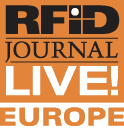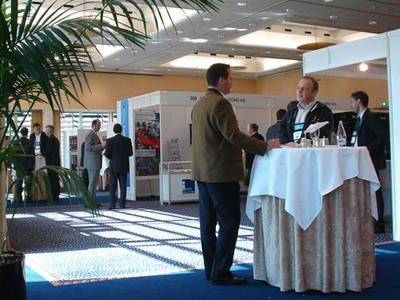RFID Live Event, Amsterdam


Probably one, if not THE biggest RFID event in europe took place this monday to wednesday in amsterdam's prestigous japanese style hotel okura.
A collection of the biggest players in RFID technology like Oracle, IBM, Unisys, amongst many others, took three days to talk about their projects, promote and network around RFID technology and it's opportunities for the retail market.

Coming from an art and design background, I could not help, but feel a little out of place amongst a community which was not only at least 15 years my senior in average, but who's agenda was obviously on the other side of the public/business divide.
The first talk to mention about the power of RFID to fight counterfeiting, led by Thorsten Staake from Auto-ID lab concluded, after some examples of how well people are producing amazingly real looking fake viagra, that the main reason, why RFID would reduce counterfeiting is, that equipping each product with tags actually makes the product more expensive. So would probably wrapping it in gold foil, but who am I to judge. A slightly dissapointing start into the talks this day.
 Nevertheless, during the following lunchbreak, taking a look at the showroom, I was pleased to not only enjoy delicious salmon, but to find out that I was not the only artist around. Offered by the RFID Journal, Den Haag's Royal Academy of Arts was present with their very own RFID Lab. As Pawel Pokutycki described it, the Lab works as, an experimental area of expertise running for about a year as a research and enabling platform for cross-disciplin projects involving RFID.
Nevertheless, during the following lunchbreak, taking a look at the showroom, I was pleased to not only enjoy delicious salmon, but to find out that I was not the only artist around. Offered by the RFID Journal, Den Haag's Royal Academy of Arts was present with their very own RFID Lab. As Pawel Pokutycki described it, the Lab works as, an experimental area of expertise running for about a year as a research and enabling platform for cross-disciplin projects involving RFID.Less surprising, I ran into Bart Schermer, founder of RFID Platform Nederland, who was very helpful getting me in contact with various RFID distributors in the Netherlands before my arrival in Rotterdam and whom I, after all those emails could finally talk to in person about future perspectives and present applications.
Inside the showroom, I noticed the so far highest density of active bluetooth devices, including two computers there were 13 devices, which made about 20% coverage. Why aren't more people using thsi feature more continously?
After an impressive presentation of Oracle's project with NASA about the storing of toxic waste, the presentation schedule finished with the most convincing case-study by Marks and Spencer's James Stafford, a lively mustached chap, who, as if it would be the easiest of all things presented M&S's usage of RFID technology on item-level for their fashion department.

A clear situation analysis about traditional barcode scanning and stock availability at the branches, showed how RFID can really improve a business, if it's deployed in exactly the right places and amounts. Monday's inventory counting process can now be done in 10% of the time and the trust in the system is so high, that these local scans are actually overwriting the centralized database information. A perfect finish to the most impressive success-stories that day was, when asked why he didnt extend such a system to the cash till, he replied "we appreciate the human factor at the cash desk and why replace a good working system that is just slow enough to ensure a bit of chit-chat between customer and staff to ensure an enjoyable shopping experience."
(image: one of M&S' first mobile RFID readers)
No further comments.
The second day, I had a chance to look at Nokia's well-working RFID-phone-shell system, integrated with their DB-Server. Limited scenario application, yet I keep admiring Nokia's approach to always supply a very open Dev Kit for everyone to play and test.
I only had half of the second day as a to meeting with Virtual Platform after lunch, so my impressions from that day's talks were rather minimal.
It is to be mentioned that the overall feeling is that of caution. With a new technology like that it is not surprising, yet the scale of the event made you assume otherwise.
In the end RFID is re-approvingly a very scenario depending technology. Like Eric Peters from TrueDemand Technology said "RFID... ...is an enabling technology." Gen2 is just getting out of it's egg and standards and regulations still differ nearly from country to country.
//
The only annoying thing about the event gose out to my men (and women) from Hotel Okura:
1) Why was the Wifi not for free?
2) Why after filling out a rather detailed web account form and purchasing half an hour of online time, surfing for 18 minutes and logging out for the next talk, I found my remaining 12 minutes gone. I purchased 30 minutes, not 18, and the auto delete excessive minutes wasn't very much mentioned as far as I remember. Not quite the class expected.
//
Thanks again to Kim Ray from RFID Journal and to Sonia Russel from Modern Media Partners for the coffee, if remember that name plate right.

0 Comments:
Post a Comment
<< Home